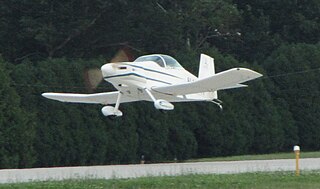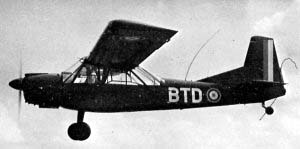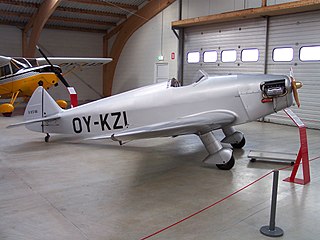The Eklund TE-1 was a Finnish-built single-seat flying boat of the late 1940s.
The Eklund TE-1 was a Finnish-built single-seat flying boat of the late 1940s.
The TE-1 was designed in late 1948 by Torolf Eklund, who was a Finnish aircraft designer for Valtion Lentokonetehdas between 1935 and 1962. The TE-1 was financed and built by Eklund as a private venture.
The TE-1 first flew in February 1949 powered by a 28 h.p. Poinsard engine. This powerplant suffered a crankcase failure, and as spare parts were no longer available, it was replaced by a Continental A40-5 engine. [1] At the time of its first flight, the TE-1 was claimed to be the world's smallest flying boat. The aircraft last flew in 1969. It is now preserved in the Suomen Ilmailumuseo (Finnish Aviation Museum) at Helsinki Vantaa airport. [2]
The following proposed derivatives were developed, but only the prototype TE-1 was completed and flown. [1]
Data from [1]
General characteristics
Performance
Related lists

The Thorp T-18 is a two-place, all-metal, plans-built, homebuilt aircraft designed in 1963 by John Thorp.

The Valmet Tuuli was a trainer aircraft, developed for the Finnish Air Force by the State Aircraft Factory. The aircraft was to be produced in 3 different versions. The last version, Tuuli III was redesigned from scratch, and is basically an entirely different aircraft.

The Brügger MB-1, MB-2 and MB-3 Colibri is a family of small sports aircraft designed in Switzerland in the 1960s and 1970s for amateur construction.

The AS/SA 202 Bravo is a two to three-seat civil light aircraft jointly designed and manufactured by the Swiss company Flug- und Fahrzeugwerke Altenrhein (FFA) and the Italian company Savoia-Marchetti. The aircraft was designated the AS 202 in Switzerland, and the SA 202 in Italy.
The Civil Aviation Department Revathi was a light utility aircraft designed in India principally for use by that country's flying clubs.
The Piper PA-6 Sky Sedan was a 1940s American four-seat light aircraft designed and built in prototype form by Piper Aircraft at its Lock Haven, Pennsylvania, factory.

The PZL-102 Kos (blackbird) is a Polish two-seat touring and training monoplane designed and built by PZL.
The Partenavia P.59 Jolly was an Italian two-seat training monoplane designed by Partenavia to meet a requirement for the Aero Club d'Italia.

The Nord 3400 Norbarbe was a French two-seat observation and casualty-evacuation aircraft built by Nord Aviation for the French Army Light Aviation.

The SAI KZ I was a sport aircraft built in Denmark in 1937, the first aircraft built by the Kramme & Zeuthen firm.
The PIK-19 Muhinu was a light aircraft developed in Finland in the early 1970s for use as a glider tug and flight trainer. It was a low-wing cantilever monoplane of conventional configuration, with an enclosed cockpit and fixed, tricycle undercarriage. Its construction was of composite materials throughout, a novel approach at the time. When the PIK-19 flew for the first time in 1972, it was only the fourth aircraft in the world made of these materials.

The Custer CCW-5 was a twin-engined, 5-seat aircraft of pusher configuration, which used a channel wing claimed to enable low speed flight and short take-offs. Two CCW-5s flew, eleven years apart, but the type never entered production.
The Scott Ol' Ironsides is an early homebuilt aircraft using wood construction with stressed fiberglass panel construction.
The Anglin J6 Karatoo is an Australian ultralight and light-sport aircraft that was designed by Jessie Anglin and introduced in 1982. Over the years the J6 Karatoo has been produced by several different manufacturers, including Amax Engineering of Donvale, Victoria, Skyway Aircraft and is currently built by Serenity Aviation of Australia. The aircraft is supplied as plans or as a kit for amateur construction.

The Bearhawk LSA is an American amateur-built light-sport aircraft, designed by Bob Barrows and produced by Bearhawk Aircraft of Austin, Texas. The aircraft is supplied in the form of plans or a kit for amateur construction.

The Fly-Fan Shark is a Slovak light aircraft designed by Frantisek Sustek and initially developed by Fly-Fan of Trenčín. Development continues under the new owner of the design, AENEA Services s. r. o.. The design was introduced at the AERO Friedrichshafen show in 2007 as a mock up and in 2011 as a flying aircraft. The aircraft first flew on 29 June 2011 and is intended to be supplied as a complete ready-to-fly-aircraft.
The Bagalini Colombo is an Italian homebuilt aircraft that was designed by Marino Bagalini. The aircraft is supplied in the form of plans for amateur construction.

The Christavia Mk I is a Canadian two-seats in tandem homebuilt aircraft designed by Ron Mason. The aircraft is supplied in the form of plans for amateur construction. Designed for missionary flying in Africa, the aircraft's name means "Christ-in-Aviation". The Christavia Mk II is a side-by-side configuration version.

The Stolp SA-900 V-Star is an American aerobatic homebuilt biplane, currently produced by Aircraft Spruce & Specialty Co in the form of plans for amateur construction. In the 1990s it was also available as a kit from Stolp Starduster Corporation of Riverside, California.
The Rokospol Via is a Czech ultralight and light-sport aircraft (LSA), designed and produced by Rokospol Aviation of Prague, introduced at the Prague airshow in 2008. The aircraft is supplied complete and ready-to-fly.
| Wikimedia Commons has media related to Eklund TE-1 . |